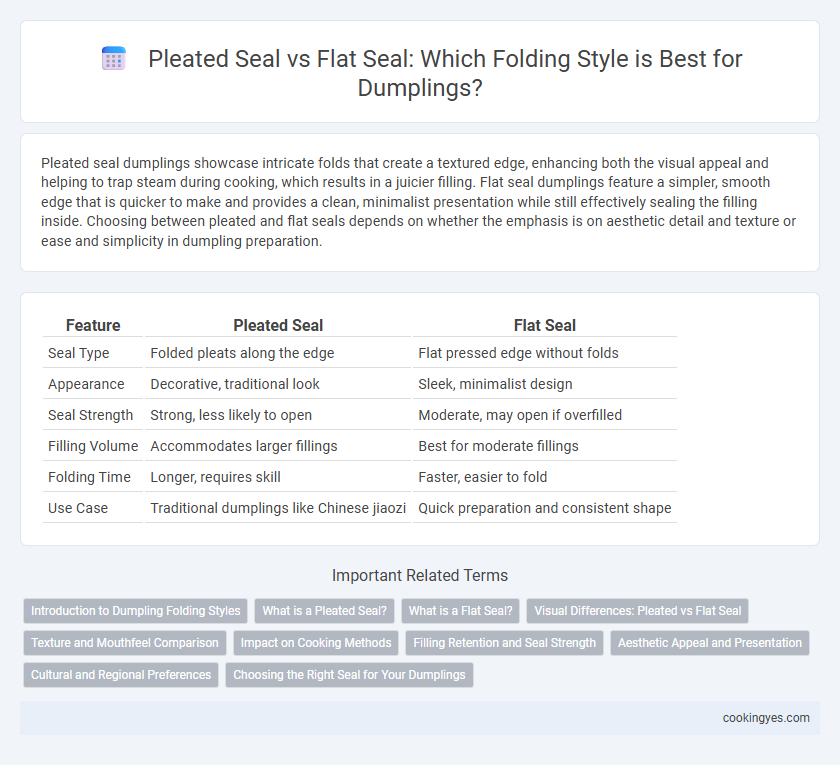Pleated seal dumplings showcase intricate folds that create a textured edge, enhancing both the visual appeal and helping to trap steam during cooking, which results in a juicier filling. Flat seal dumplings feature a simpler, smooth edge that is quicker to make and provides a clean, minimalist presentation while still effectively sealing the filling inside. Choosing between pleated and flat seals depends on whether the emphasis is on aesthetic detail and texture or ease and simplicity in dumpling preparation.
Table of Comparison
| Feature | Pleated Seal | Flat Seal |
|---|---|---|
| Seal Type | Folded pleats along the edge | Flat pressed edge without folds |
| Appearance | Decorative, traditional look | Sleek, minimalist design |
| Seal Strength | Strong, less likely to open | Moderate, may open if overfilled |
| Filling Volume | Accommodates larger fillings | Best for moderate fillings |
| Folding Time | Longer, requires skill | Faster, easier to fold |
| Use Case | Traditional dumplings like Chinese jiaozi | Quick preparation and consistent shape |
Introduction to Dumpling Folding Styles
Pleated seal and flat seal are two primary dumpling folding styles, each affecting texture and cooking performance. The pleated seal features intricately folded edges that create a visually appealing, layered finish and allow steam to escape evenly during cooking, enhancing the dumpling's tenderness. The flat seal offers a simpler, smoother edge that provides a uniform shape and seals the filling securely, ideal for pan-frying or boiling without compromising structural integrity.
What is a Pleated Seal?
A pleated seal in dumpling folding involves creating multiple small folds along the edge of the wrapper to form a decorative, ridged pattern that securely holds the filling inside. This technique enhances the dumpling's structural integrity by evenly distributing pressure, reducing the risk of filling leakage during cooking. The pleated seal is commonly used in traditional styles like Chinese jiaozi and Japanese gyoza, offering both aesthetic appeal and functional durability.
What is a Flat Seal?
A flat seal in dumpling folding style involves pressing the edges of the wrapper together without creating pleats, resulting in a smooth, streamlined appearance. This method provides a tighter seal, helping to prevent fillings from leaking during cooking, and is often used for simpler, rustic dumplings like jiaozi. Compared to pleated seals, flat seals require less skill and time, making them ideal for quick preparation while still ensuring a secure closure.
Visual Differences: Pleated vs Flat Seal
Pleated seal dumplings feature a series of intricate folds that create a textured, ridged edge, enhancing their visual appeal and signaling a traditional handmade touch. Flat seal dumplings have smooth, pressed edges that form a clean, uniform line, offering a simpler and more streamlined appearance. The pleated seal's detailed ridges contrast sharply with the flat seal's plain border, making the sealing style instantly recognizable.
Texture and Mouthfeel Comparison
Pleated seal dumplings feature multiple folds creating a textured, ruffled edge that adds a satisfying chew and visual appeal, enhancing the overall mouthfeel by providing contrast between the smooth dough and layered folds. Flat seal dumplings offer a simpler, smooth edge that produces a softer bite with consistent dough thickness, resulting in a delicate, tender texture without the chewiness of pleats. The choice between pleated and flat seals significantly influences the dumpling's tactile experience, balancing between a more complex bite and a silky, uniform texture.
Impact on Cooking Methods
Pleated seal dumplings create multiple folds that trap steam and moisture, making them ideal for steaming and boiling as the pleats help retain juiciness and enhance texture. Flat seal dumplings, with their smooth, less crimped edges, are better suited for pan-frying and deep-frying because the even seal prevents oil from seeping inside, resulting in a crispy exterior. The choice between pleated and flat seals directly influences heat distribution and moisture retention, affecting the dumpling's final cooking outcome and flavor profile.
Filling Retention and Seal Strength
Pleated seals in dumpling folding create multiple folds that enhance filling retention by securely trapping ingredients, reducing leakage during cooking. Flat seals rely on a simple pressed edge, which offers less structural integrity and may lead to filling escaping under heat or pressure. The pleated seal's reinforced edges provide greater seal strength, making it preferable for juicy or heavily filled dumplings.
Aesthetic Appeal and Presentation
Pleated seals create intricate, decorative ridges that enhance the aesthetic appeal of dumplings, making them visually striking and elegant for presentation. Flat seals offer a minimalistic, smooth edge that highlights simplicity and uniformity while maintaining a neat, polished appearance. Choosing between pleated and flat seals impacts the dumpling's overall visual impression, influencing the dining experience through refined craftsmanship or subtle elegance.
Cultural and Regional Preferences
Pleated seal dumplings, characterized by intricate folds, are predominantly favored in Northern China and Japan, symbolizing craftsmanship and aesthetic appeal in traditional cuisine. Flat seal dumplings, common in Southern China and Korea, emphasize simplicity and practicality, reflecting regional preferences for speed and ease in preparation. These folding styles not only affect the texture and cooking method but also carry cultural significance tied to local customs and festive traditions.
Choosing the Right Seal for Your Dumplings
Choosing the right seal for your dumplings depends on the desired texture and presentation; pleated seals create a decorative, intricate edge that offers a slightly chewier bite, while flat seals provide a simpler, cleaner look that ensures even cooking and a tender finish. Pleated seals are ideal for dumplings like jiaozi or gyoza, where the folded design enhances both grip and steam retention, whereas flat seals suit wontons and quick-cook dumplings requiring a smooth, watertight closure. Selecting between pleated and flat seals can impact the culinary experience by influencing dumpling shape, cooking method, and overall mouthfeel.
Pleated Seal vs Flat Seal for Dumpling Folding Styles Infographic

 cookingyes.com
cookingyes.com